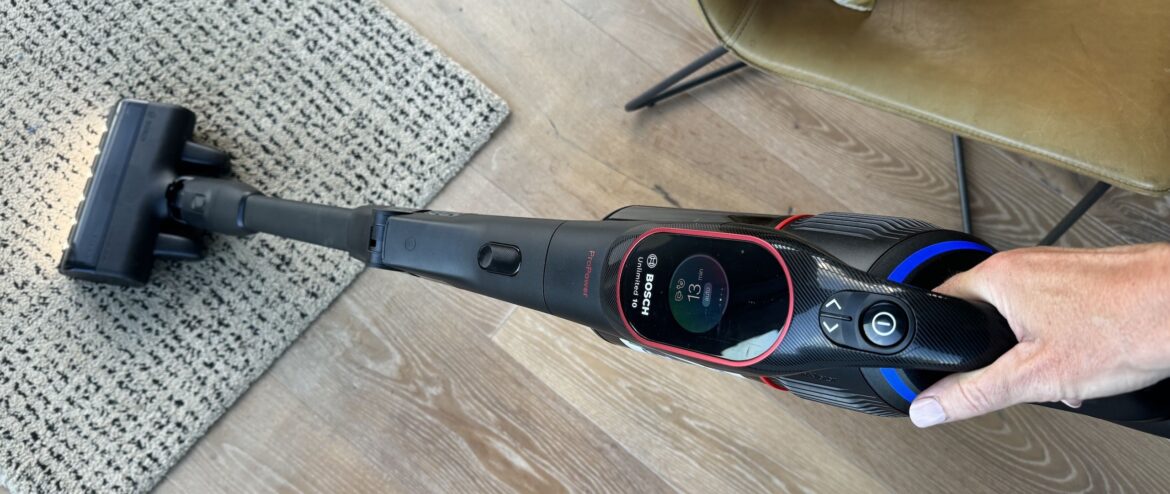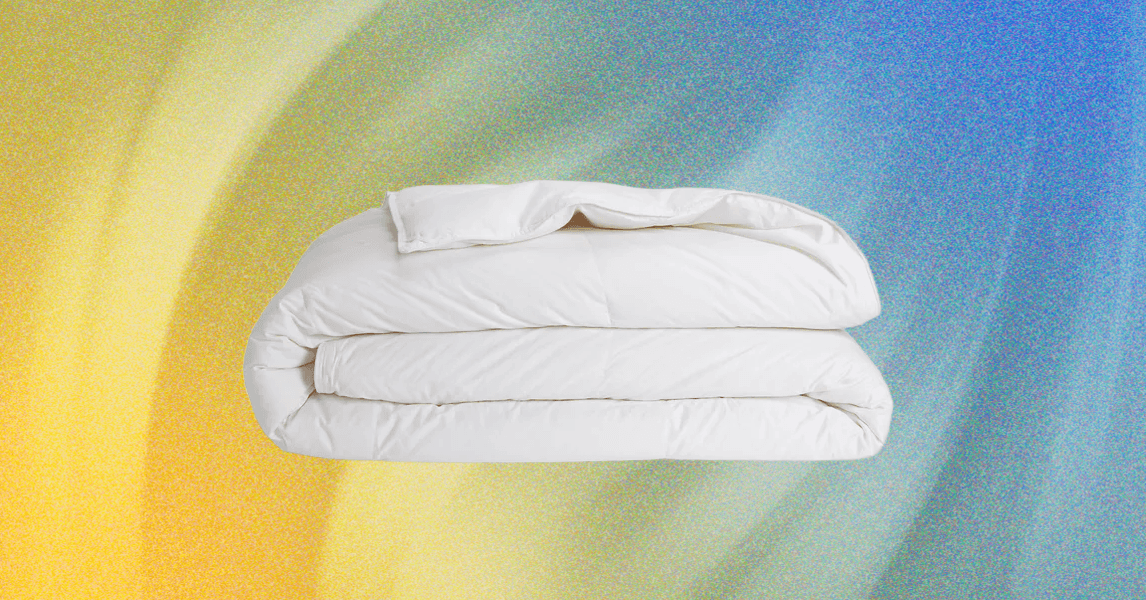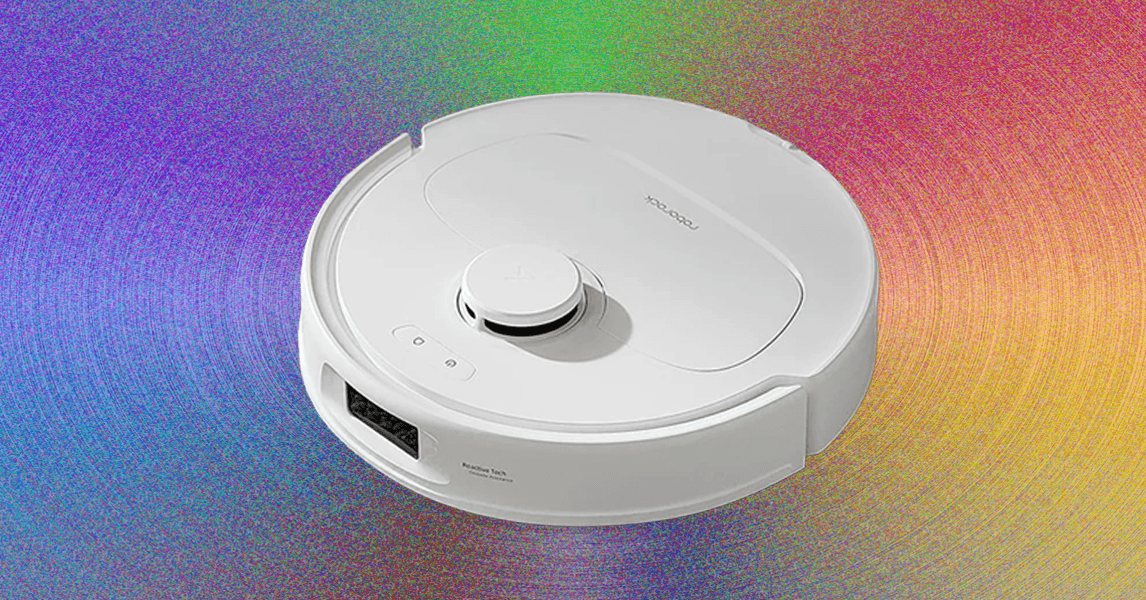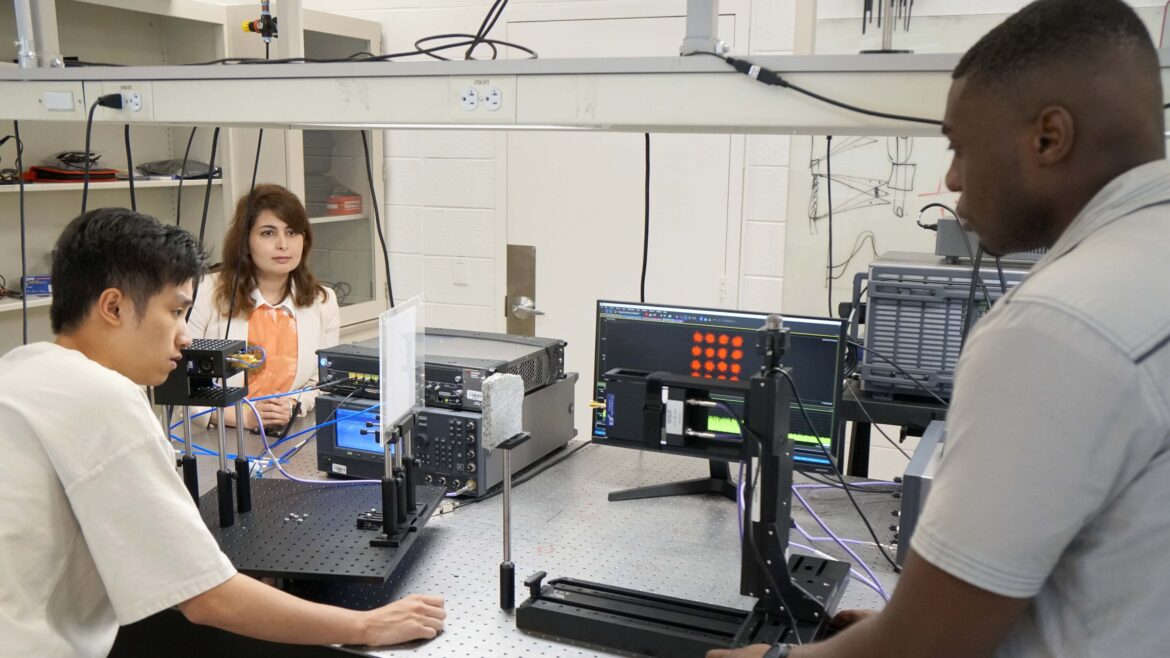Why you can trust TechRadar
We spend hours testing every product or service we review, so you can be sure you’re buying the best. Find out more about how we test.
Bosch Unlimited 10: two-minute review
Product info
There are two slightly different versions of the Bosch Unlimited 10 vacuum. For this review, I tested the BCS1051GB, sometimes called the Unlimited 10 ProPower. It’s all black and has a slightly better battery.
There’s also the BBS1041GGB, which has a gray plate on the front and slightly shorter runtimes. It’s also cheaper.
The Bosch Unlimited 10 vacuum cleaner, launched in March 2025, is a clear step up from the Unlimited 9. Where the older model offered a 60-minute runtime, three cleaning modes and a 105-minute charge time, the Unlimited 10 ProPower bumps it up to an impressive 100-minute runtime, six cleaning modes, and a much faster 60-minute recharge via the fast-charger supplied. It also adds a forward-bending wand for easier under-furniture cleaning and a hi-tech, interactive display.
Bosch is well-established in home appliances but less dominant in cordless vacuums, and the Unlimited 10 feels like its most serious challenger to Dyson and Shark yet. On test, it delivered consistently strong results on hard floors and carpet alike, with the added flexibility of its extended runtime if you invest in extra batteries. Its smart touch control fascia and LED ring that provides a visual indicator of dust-busting progress will appeal to tech geeks. But, if you want to be really nit-picky, its small dustbin, a floorhead that lacks anti-hair wrap features, and overall weightiness are slight drawbacks.
It’s not quite the Dyson-slayer Bosch might have been aiming for, but the Unlimited 10 is easily one of the best cordless vacuum cleaners I’ve tested so far this year. If you’re on the hunt for impressive suction, long runtimes and easy handling, this one’s a clever, future-proof contender. Keep reading as I dive into its design, performance and value to see if the Bosch Unlimited 10 is the best vacuum cleaner for you.
Everything that came in the box for my review model (Image credit: Future)
Bosch Unlimited 10 ProPower review: price & availability
- List price: from £569.99
- Launch date: March 2025
- Availability: UK and Europe
The Bosch Unlimited 10 BCS1051GB hit the shelves in March 2025 and is currently available across the UK and Europe. Rather confusingly, there is also a slightly lower spec Unlimited 10 BBS1041GGB model in graphite, which was launched at the same time with a RRP of £569.99 (already on offer at £419.99), but, at the time of writing, the black version – sometimes called the ‘ProPower’ – I tested sits squarely at £629.99.
Both versions share the same core cleaning tech, but the main advantage of the BCS1051GB is its larger 5.0 Ah battery, offering up to 100 minutes of runtime (vs 80 minutes with 4.0 Ah). If you’re happy to go for the older Unlimited 9, prices now start from £399.99, so there’s a decent saving to be had there.
One of Bosch’s big selling points is its swappable battery system, which works across more than 100 devices from over 10 brands, making it easy to swap batteries and avoid buying and storing multiple chargers. If you want to double your runtime on the Unlimited 10 ProPower vacuum you’ll need to budget another £137.41 for a second battery pack.
Price-wise, the Bosch Unlimited 10 ProPower lands in the premium bracket of stick vacuums, especially if you pony up for that extra battery, rubbing shoulders with Dyson’s V15 Detect and Shark’s flagship models. On paper, that’s a big ask, but the Bosch claws back some value with its long runtime, six cleaning modes and clever flexible tube. At full price it feels expensive, but as the entry level Unlimited 10 is already discounted by £150 on Bosch’s own website, I predict it won’t be long before the ProPower is on offer, too.
- Value for money score: 3.5 out of 5
Bosch Unlimited 10 ProPower specs
Swipe to scroll horizontally
Model:
BCS1051GB ProPower (reviewed)
BBS1041GGB
Weight:
3.8 kg
3.8 kg
Dimensions (H x W x D):
130 x 25 x 21.6 cm
130 x 25 x 21.6 cm
Floorhead width:
25cm
25cm
Filter:
HEPA
HEPA
Bin capacity:
0.4L
0.4L
Battery:
18v 5.0 Ah
18 V 4.0 Ah
Max runtime:
100 mins
80 mins
Charge time:
60 mins
90 mins
Bosch Unlimited 10 ProPower review: design
- Stylish stick vacuum with touchscreen controls, but a tad bulky
- Compression lever to squish dirt and aid with bin emptying
- Foot presser for no-bend tool switching
With its matte black finish and streamlined design, the Bosch Unlimited 10 ProPower makes a strong first impression. It boasts a distinctly more premium look than the brand’s earlier vacuums, and while it’s not the most lightweight cleaner out there, but its slightly hefty build does feel reassuringly substantial.
Like most cordless sticks, this vacuum can be configured as a standard upright stick or a handheld, just by plugging the floorhead or upholstery tools into the main unit. I’d have liked a mini turbo brush for getting dog hairs out of the sofas (we have two spaniels), but the extra-long upholstery nozzle with soft rubbery construction that doesn’t scratch the skirting boards was a welcome addition.
The foot pedal makes it easier to release the floorhead without bending down (Image credit: Future)
Swapping out nozzles is especially satisfying, thanks to the handy foot-release pedal on the floorhead, which means you don’t need to bend down every time you want to switch. (Dyson has addressed the same problem on its V16 Piston Animal, except that model uses a slide-down cuff at the top of the wand rather than a foot pedal.)
The wall-mounted docking station is designed to charge the unit when docked so there’s also no need to manually connect the charging cable. If you prefer, and need a fast recharge, you can slide the battery off and charge it in the battery charging unit supplied.
The fast charger gets the battery to full power in just over an hour (Image credit: Future)
Another excellent design feature is the compression lever on the dust bin, which pushes down debris. It’s useful both for squishing the dirt in the bin to make room for more, and for ejecting everything efficiently when it’s time to empty the bin. It meant I didn’t have to get my hands dirty fishing out tangled fluff or hair stuck around the filters. (Incidentally, this is another feature that also appears on the new Dyson V16.)
I loved the touchscreen display, which replaces traditional buttons with a clear, modern interface. You can scroll through the six cleaning modes (Eco, Auto, Turbo, Silent, Car and Delicate), and it also has tutorials on emptying the bin, cleaning filters and so on, so you’ll never have to go hunting for the instruction manual.
The touchscreen is easy and intuitive to use and keeps you abreast of power levels and other key info (Image credit: Future)
Anyone and everyone, but especially those with mobility issues, will appreciate the Unlimited 10’s flexible main pipe, which has a button that lets it bend forwards to a 90-degree angle. This makes sliding the vacuum under sofas, beds, and low or leggy furniture much easier, with no need to crouch down or manhandle heavy furniture.
Press a button and the main hose turns into your flexible friend (Image credit: Future)
This feature isn’t exclusive to Bosch – in fact, it appears on a number of the best Shark vacuums – but it is a welcome addition nonetheless. I used it a lot more than I thought I would, and got a great deal of joy from listening to all the unseen dust and dirt being sucked up from my home’s deepest, darkest voids.
Bosch Unlimited 10 review: performance
- Packs a powerful punch on hard floors and carpets
- Auto mode nails switching across different surfaces
- Super easy to empty, but the dark bin and weight are niggles
With two hairy dogs, messy kids, and a busy family home that always seems to be one mealtime away from total chaos, the Bosch Unlimited 10 had plenty to prove, and I’m delighted to report it did us proud. The bendy wand seemed gimmicky but turned out to be extremely nifty for scooting under sofas, while the floorhead twists nimbly around chair legs and hugs skirting boards. I loved the bright LEDs on the floorhead too: there’s nothing like seeing the hidden dust bunnies lit up before they disappear.
Powerful headlamps make dirt detection easier (Image credit: Future)
Downstairs in my home I have a mix of flooring, primarily hard (wood, porcelain, laminate and terracotta) with a few rugs thrown in, and upstairs is mainly carpet. On hard floors the Bosch Unlimited 10 glided along effortlessly, and when I hit a rug, I could really feel the suction crank up. Auto mode got it spot-on every time, even showing the floor type on the monitor screen, while Turbo is a bit wild on thick carpets but brilliant for the car mats and dog beds.
Day to day, I mostly stuck to Auto and Silent modes, both are more than enough for crumbs, fur and stray feathers (did I mention we also have a budgie?). Silent, in particular, kept things calm without losing too much oomph on the suction front. When I needed extra muscle, Turbo mode swooped in for stubborn dirt or the sofa cushions.
The main floorhead works well on upholstery but I’d have liked a smaller one (Image credit: Future)
Crucially, it didn’t do that annoying thing where bigger crumbs get batted around instead of sucked up; everything just disappeared in one or two passes. And although my decibel monitor app measured noise levels between 65 and 72dBA across modes, none of them had me worried the neighbors might complain.
I’ll admit there are two modes I probably won’t use much – Car mode and Delicate Carpet mode – but for the sake of this review, I gave them a spin. Car Mode sits somewhere between Auto and Turbo in terms of power, and is designed for nozzle work in the nooks and crannies of your car. Normally, I leave that job to our local valet, but it gave a solid “interim clean” performance – not valet-level, but good enough to freshen things up between visits.
Delicate Carpet mode, meanwhile, turns off the rollers and relies on suction alone, making it ideal for more sensitive floor coverings like sisal, silk, or any rug that hates a beater bar. I only have one rug that qualifies, but it handled it gently and effectively.
The red button slides down to drag the bin contents out (Image credit: Future)
Cleaning out the bin and dust-busting the filter is surprisingly fuss-free. The lever in the bin, which you slide down from the outside, means you can compress the contents of the bin to fit more in (useful because the bin itself is very small). It also comes into its own when it comes to emptying – no more grim moments fishing out clumps of fur.
The twist-to-clean filter is oddly satisfying too: you just hold the filter over the bin and turn the top of the filter and some magic within flicks all the dust out. An alarming amount of dust in fact, which is surely just a sign that the filter really must be very good, not that my house is exceptionally dirty?
Sadly, the Bosch Unlimited 10 isn’t entirely perfect. Disappointingly, the floorhead roller did collect its fair share of hair while I was cleaning. Most vacuum makers have solved this issue now, with anti hair-wrap features. The roller pops out easily, so it’s relatively easy to snip away tangles with scissors or a sharp knife, but I’d wouldn’t expect to have to do this on a premium-priced vacuum.
The roller wasn’t too bad with hairs, but a few stray strands lingered (Image credit: Future)
The dark-grey dustbin makes it tricky to see when it’s full unless you peer closely. It’s also a bit heavy – after about 10 minutes on the stairs I definitely felt the weight of the Unlimited 10 in my arms, and after testing the battery life, my arm was nearly ready to drop off. I exaggerate, but it was certainly one of the heavier stick vacuums I have reviewed, and I wouldn’t necessarily recommend it for anyone who is elderly or infirm.
Another key feature of the Bosch Unlimited 10 worth mentioning is its MicroClean LED ring. The Tineco Pure One X and Shark PowerDetect has similar tech, and it’s essentially designed to give you visual feedback on cleanliness levels/progress as you clean. The ring glows red when it’s still picking up dust and debris, then flips to blue once the area is spotless. The idea is that it takes the guesswork out of knowing when you’ve done enough passes.
I’ll be honest, I’m generally happy to trust my eyes to tell me whether a floor looks clean, and I didn’t really pay much attention to the LEDs, so I’m not sure how useful it really is for me. That said, anyone who frets about hidden dirt or just likes a reassuring visual prompt might appreciate this feature.
The LED halo changes colour to indicate cleaning is complete (Image credit: Future)
Suction tests
To really put this vacuum through its paces, I set up a few very scientific (erm, slightly chaotic) tests using oats and teabags across hard floors and carpets. It felt a bit like hosting a chimp’s tea party and the dogs trying to eat my testing material didn’t help matters, but it definitely showed what this vacuum was made of.
First up, I ripped open a teabag and sprinkled its contents across the hard flooring (engineered oak boards) in the kitchen. In the lowest power setting, Eco mode, the Unlimited 10 guzzled those tealeaves up in one sweep, no mess left behind, no repeat passes needed to get that blue LED light ring assurance the floor was clean. Honestly, I was embarrassingly giddy at how satisfying it was watching the tea vanish, even from the grooves between the floor planks.
Over on the carpet though, it was a different story: Eco just wasn’t enough. Switching up to Turbo mode gave it the grunt it needed, and once I did that, the tea leaves were gone in seconds.
Image 1 of 2
(Image credit: Future)
Teabag test
(Image credit: Future)
Next came the oats, about 30g of finest Scottish Porridge Oats scattered across the floor like confetti. On hard flooring, Eco Mode struggled a bit: the vacuum dragged the oats backwards, leaving them behind. I quickly learned that lifting the head slightly and giving Turbo mode a spin sorted them out without fuss. It wasn’t the smoothest pass, but it did the job quickly enough. On carpet, it was oddly easier. Eco did most of the work, but I did ramp it up to Turbo to nab the last few stubborn bits.
Image 1 of 2
(Image credit: Future)(Image credit: Future)
carpet test
Finally, I checked out how well this vacuum handled edge cleaning. I sprinkled a line of tea right along the skirting board in the kitchen. Running the vacuum parallel left a faint dusty line, but as soon as I changed tack and went in head-on at a right angle, it snaffled up the lot. So yes, you’ll probably still want the crevice tool now and then, but with a bit of maneuvering the main floorhead is surprisingly capable at perimeter duty.
If you approach it from the correct angle, the edge cleaning is excellent (Image credit: Future)
All in all, these “tea and oats” experiments were a good stress test, and while not every mode was perfect for every mess, the Unlimited 10 handled everything I threw at it without too much drama or excessive time wasting.
- Performance score: 4.5 out of 5
Bosch Unlimited 10 review: battery
- For the BCS1051GB ProPower version:
- Up to 87 minutes in Eco, 32 in Auto, 30 in Silent, and 14 in Turbo
- Fast recharge in just over an hour – barely enough time for a nap
- Battery works across Bosch’s 18V All Alliance range
Note, in this section I’ll be focusing on the Unlimited 10 BCS1051GB ProPower model, which has a slightly better battery than the BBS1041GGB.
Battery life is one of the Unlimited 10’s real strengths. In Eco mode, I clocked a solid 87 minutes, which is more than enough for multiple cleans or one mega session. Auto mode, which I used most, lasted about 32 minutes – no doubt helped by the fact my home is at least 70% hard flooring, while Silent mode gave me around 30 minutes of cleaning time. If you’re a suction-obsessed cleaner and stick to Turbo mode, you’re looking at just 14 minutes, so if your home is wall-to-wall carpet you might want to budget for a spare battery.
Recharge time was another bonus. From empty to full, it took just over an hour, which is slightly more than Bosch’s claim, but still super quick compared to most rivals. I could plug it in before lunch, and it would be ready to go again by the time I’d eaten and caught up on my Socials.
Another noteworthy trick is that the battery is part of Bosch’s 18V Power For All Alliance, which means you can swap it into more than just your vacuum – from power drills to hedge trimmers. It’s a small thing, but being able to share batteries across gadgets is genuinely useful, especially if you’re already in the Bosch ecosystem.
For day-to-day cleaning, I’d rate the battery life excellent. I managed to get around my four-bed Victorian house in one charge, as long as I resisted leaning on Turbo too much. For a cordless, that’s pretty impressive, and it takes away a lot of the range anxiety I used to get from early stick vacuums.
- Battery life score: 4.5 out of 5
Should you buy the Bosch Unlimited 10?
Swipe to scroll horizontally
Attribute
Notes
Rating
Value for money
Premium price, but justifiable with strong suction, smart features, and quick-charging battery, especially if you’ve already bought into Bosch’s battery-sharing system.
3.5/5
Design
Sleek and modern with clever touches like a bendy pipe, foot-release floorhead, and touchscreen controls, though its top-heavy build won’t suit everyone.
4/5
Performance
Excellent on hard floors and carpets, with smart Auto mode, bright LEDs, and easy maneuverability.
4.5/5
Battery
Impressive runtimes across most cleaning modes and a rapid one-hour recharge, easily catering for a family-sized home.
4.5/5
Buy it if…
Don’t buy it if…
How I tested the Bosch Unlimited 10 ProPower
I put the Bosch Unlimited 10 ProPower through its paces for four weeks over the summer holidays — the absolute messiest time of year in our house. With two dogs, two daughters riding most days, and the endless trail of hay, horsehair, and snack crumbs that comes with it, our four-bedroom Victorian home in deepest Devon was a perfect test ground. We’ve got a mix of hard floors and carpet, so I was able to see how well it adapted to different surfaces, as well as how it coped with daily chaos.
I used all the attachments and functions, from the detail brush on the sofas and stairs to the bendy wand for reaching under beds. I ran proper “mess tests” too – oats and teabags scattered across both carpets and hard floors – and I checked how close it could get to edges without switching to the crevice tool. I also kept tabs on battery life, recording runtimes across Eco, Auto, Silent and Turbo modes, and timed how long it took to recharge.
To round it out, I used a decibel meter app to measure noise levels in each mode, because I wanted to know if it was genuinely quiet or just “quiet for a vacuum.” I lived with it as our only vacuum, using it on everything from dog hair tumbleweeds to post-dinner disasters, and came away with a clear sense of how it performs in real life.
Read more about how we test vacuum cleaners.
First reviewed August 2025






